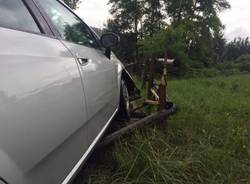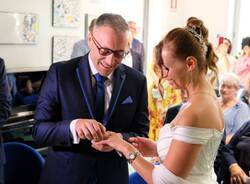Arches and bricks, what a surprise the farmsteads of Caidate are
A lot of visitors on the only weekend of Spring Days organised by the FAI, who also organised a tour of the village of Sumirago and of the hamlet of Caidate.
The farmsteads of Caidate are a surprise: not small farms, but elegant, well-organised complexes among the hills, that would not look out of place among the large courtyards on the plain.
The Immacolata, Crocifisso and Vittoria farmsteads are a special characteristic of this village on a hill, connected to the investments made by the owners (in the nineteenth century) in a territory where instead it is rare to see farming facilities resulting from a precise plan designed to bring several families together.
This example of local heritage, which is little known (except for some quotes in books about the local agricultural architecture), was at the centre of the last “Autumn Days” organised by the Seprio branch of the Italian Environmental Fund (FAI) and well run especially by the Youth group. In accordance with the tradition concerning the Days, two nineteenth-century farmsteads were included in a small local tour, “which included Villa Molino in Sumirago, and the two farmsteads in Caidate.”
Today, Villa Molino is the headquarters of the village council, a fine building of eighteenth-century origin, around which the village gradually grew; it has been owned by the cloister of Brera in Milan, by the Colleoni family and then, in the nineteenth and twentieth centuries, by the Stanga marquises.
In the nineteenth century, the hamlet of Caidate saw a flourishing of carefully planned farmsteads, the result of a precise investment and rational design. In chronological order, the first was the Crocifisso Farmstead, which was built between 1865 and 1875, at the behest of Count Luigi Confalonieri, and it is a completely enclosed courtyard.
On one side, there is the high three-storey building with the farmers’ houses (rigorously open to the South, to exploit the heat), on the other, there are the stables with haylofts. On both sides, a long boundary wall (on which the portico rests) closes the courtyard. The buildings alternate brick and plaster, which give them a vaguely neo-medieval look, which at the time (in the early years of the Unification of Italy) symbolised the rediscovery of an ancient freedom which had long been denied by foreign domination.
A pleasant neo-gothic touch also characterises the main building and part of the outbuildings of the Immacolata Farmstead, which was built in 1870, which, still today, is all but isolated among the fields and woods, albeit not far from the village. On the opposite side of the village, there is the Vittoria Farmstead, although it is smaller, with the main building which has seven arches on each floor; under the portico, an alcove is home to a small chapel of the Madonna, an element that is certainly traditional, that spread even more in the second half of the nineteenth century, a sign of the upsurge of Marian worship.
It is difficult to visit the farmsteads in Caidate, and maybe this also explains the particular success of the FAI’s Autumn Days, when the opportunity was given to have a guided visit of the Crocifisso and Immacolata farmsteads.
“The mayor of Sumirago had already suggested opening up for the FAI Spring Day, but it fell through because of the lockdown,” explained Martina Carù of the FAI’s Youth Group, in Seprio. “According to the programme, we should also have suggested a little church, but the place was too small and we had to exclude it.” Carù explained that the Seprio Youth Group and Branch of the FAI had “a larger influx of people than was expected,” which they managed, with organised groups (of a few people) that maintained distancing.
The Immacolata Farmstead is still used today for farming, and is inhabited, but the Crocefisso Farmstead has been uninhabited since the ’90s. It is hard to recognise the splendour of old, when the two farmsteads stood out (symbolically, but also physically) above the smaller, unhealthy houses of farmers in the area. The FAI Days brought life back to the place, making it possible to pass on experiences: “An 80-year-old woman told us what life was like at Crocefisso Farmstead, about the farm of silkworms, and the drying of silk on the meadows, before it was brought to the castle.”
The Castle is not far away; it was first the home of the Viscontis, then of the Biglis, before passing to the Confalonieris, who made it the centre of a huge farming propriety. Of ancient origin, today, the castle also includes, in part, nineteenth-century buildings, inspired by the mythological Middle Ages, which can also be seen in the farmstead; another stopover that we can add to out little tour of Caidate.
Translated by Sara Francesca, Denise Mura and Michela Villa
Reviewed by Prof. Rolf Cook
TAG ARTICOLO
La community di VareseNews
Loro ne fanno già parte
Ultimi commenti
Roberto Ganna su Elsa Fornero a Varese: “Abbiamo tolto futuro ai giovani. Ora dobbiamo restituirglielo”
Baffetta su Elsa Fornero a Varese: “Abbiamo tolto futuro ai giovani. Ora dobbiamo restituirglielo”
Fabrizio Tamborini su Elsa Fornero a Varese: “Abbiamo tolto futuro ai giovani. Ora dobbiamo restituirglielo”
Alessandro Zanzi su Elsa Fornero a Varese: “Abbiamo tolto futuro ai giovani. Ora dobbiamo restituirglielo”
Emanuele Zanetti su Motociclista di Ferno ucciso da un orso in Romania
GrandeFratello su Superate le 700 firme per la petizione sul recupero del Grand Hotel Campo dei Fiori di Varese
















Accedi o registrati per commentare questo articolo.
L'email è richiesta ma non verrà mostrata ai visitatori. Il contenuto di questo commento esprime il pensiero dell'autore e non rappresenta la linea editoriale di VareseNews.it, che rimane autonoma e indipendente. I messaggi inclusi nei commenti non sono testi giornalistici, ma post inviati dai singoli lettori che possono essere automaticamente pubblicati senza filtro preventivo. I commenti che includano uno o più link a siti esterni verranno rimossi in automatico dal sistema.